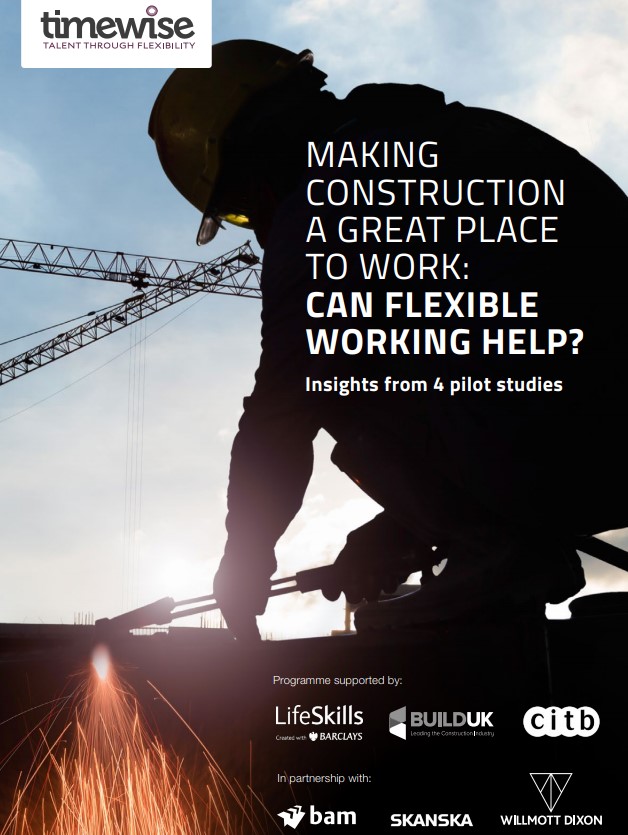Flexible working in engineering services
Construction and engineering services, like other front-line sectors, have been slow to integrate working arrangements that give a degree of flexibility on how long, where, when and at what times employees work.
There are several barriers to this slow take-up of flexible working, from the interdependency of roles to the fragmentation of the workforce between different tiers. These mean that flexible working has been considered almost a taboo subject. However, a 2021 pilot study provides much needed insight into how to look beyond these barriers to realise the rewards of flexible working.
The reasons for industry to begin to progress a more flexible approach are persuasive, including addressing the skills shortage through attracting and retaining a more diverse workforce. The report identifies the under-representation of women and the attractiveness of flexible working to women, given that they are more likely to have caring responsibilities.
The study also highlights broader concerns – applicable to everyone, regardless of gender – about work-life balance, the long hours culture and the need to address wellbeing and worrying suicide rates. Whilst flexible working is not presented as the panacea to all industry woes, it offers the opportunity, as part of a workforce strategy, to begin to address these concerns.
The pilot study, which was commissioned by Build UK, involved four large main contractors: BAM Construct; BAM Nuttall; Skanska UK; and Willmott Dixon. Each introduced tailored flexible working practices onto different project sites, ranging in size between 14 and 120 employees.
The specific practices trialled in this way included:
- A team-based consultative approach, allowing workers to submit preferences for working patterns that met planned and defined business needs.
- A flexi-day in which workers could accumulate additional hours in exchange for one day off each month.
- An output-based approach which meant that workers could leave once their work for the day was completed rather than remain on site to complete their contracted hours.
- Staggered start and finish times whereby the foreman alternated start times between two teams coupled with a choice of break time.
The reported results were encouraging.
Feedback from participants showed a significant increase in wellbeing from 43% to 84%. Qualitative feedback from managers highlighted a greater sense of trust and empowerment. All four firms reported no impact on budgets or timeframes.
The report – entitled Making Construction a great place to work: Can flexible working help? – provides useful guidance on the need for a controlled and measured approach to the implementation of flexible working. This starts with a vision and buy-in at the top. The report also recommends a trial run before any wider roll-out, plus clear criteria for measuring outcomes.
Finally, the report highlights the need to review management capability and address any training needs this identifies.
Timewise have compiled a 10-step plan to incorporate these learning points which can be found here.
The Timewise pilots attempted to break the taboo of flexible working for site-based staff. In carefully selected, small-scale projects this now looks practicable. This is a small step for industry to begin to embrace the flexible working challenge and to expand provision for inclusive flexible working practices for all staff.
If you have any questions on introducing flexible working, please contact the ECA Employee Relations Advisory Service at [email protected] or 020 7313 4800.
This article originally appeared on the ECA website under the headline, 'Breaking the Taboo: Flexible working in Engineering Services'. It was written by Catherine Watt, Head of Employee Relations, and published on 27 July 2021.
--ECA
[edit] Related articles on Designing Buildings Wiki
- Articles by the Electrical Contractors' Association (ECA).
- A 10 point plan to overcome the construction and infrastructure skills gap.
- Balance for better: why lack of diversity is an issue for everyone.
- Diversity in the construction industry.
- Post pandemic places report.
- Skills shortage.
- Tackling the construction skills shortage.
- Women in the construction industry.
- Work from home trends influence closed plan home preferences.
[edit] External resources
Featured articles and news
RTPI leader to become new CIOB Chief Executive Officer
Dr Victoria Hills MRTPI, FICE to take over after Caroline Gumble’s departure.
Social and affordable housing, a long term plan for delivery
The “Delivering a Decade of Renewal for Social and Affordable Housing” strategy sets out future path.
A change to adoptive architecture
Effects of global weather warming on architectural detailing, material choice and human interaction.
The proposed publicly owned and backed subsidiary of Homes England, to facilitate new homes.
How big is the problem and what can we do to mitigate the effects?
Overheating guidance and tools for building designers
A number of cool guides to help with the heat.
The UK's Modern Industrial Strategy: A 10 year plan
Previous consultation criticism, current key elements and general support with some persisting reservations.
Building Safety Regulator reforms
New roles, new staff and a new fast track service pave the way for a single construction regulator.
Architectural Technologist CPDs and Communications
CIAT CPD… and how you can do it!
Cooling centres and cool spaces
Managing extreme heat in cities by directing the public to places for heat stress relief and water sources.
Winter gardens: A brief history and warm variations
Extending the season with glass in different forms and terms.
Restoring Great Yarmouth's Winter Gardens
Transforming one of the least sustainable constructions imaginable.
Construction Skills Mission Board launch sector drive
Newly formed government and industry collaboration set strategy for recruiting an additional 100,000 construction workers a year.
New Architects Code comes into effect in September 2025
ARB Architects Code of Conduct and Practice available with ongoing consultation regarding guidance.
Welsh Skills Body (Medr) launches ambitious plan
The new skills body brings together funding and regulation of tertiary education and research for the devolved nation.
Paul Gandy FCIOB announced as next CIOB President
Former Tilbury Douglas CEO takes helm.
UK Infrastructure: A 10 Year Strategy. In brief with reactions
With the National Infrastructure and Service Transformation Authority (NISTA).
























